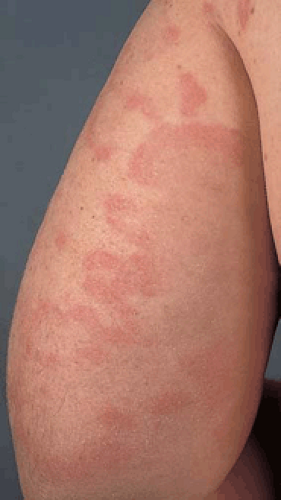Urticaria
Larry E. Millikan
(ICD-9 708.9)
Symptoms and Signs
Urticaria is pruritic. The degree of pruritus depends on the amount of swelling. Patients often say they can watch the lesions come and go within hours. The lesions are evanescent and migratory and do not last beyond 24 hours. Urticaria presents as elevated and edematous plaques, usually pale red or pink. As the lesions spread, there is often a central clearing, which leaves an arcuate or gyrate formation (Fig. 15-1).
Urticaria may be acute or chronic. By definition, acute urticaria lasts less than 6 weeks, and chronic urticaria lasts longer. The causes of either are rarely found. Common precipitants include salicylates and penicillins. Salicylates are found in spearmint and wintergreen flavors as in toothpaste, candies, and tomatoes. Penicillins can be found in bleu cheese dressing and some dairy products. Menthol is the culprit in peppermint toothpaste or
mentholated cigarettes. Other causes include foods (seafoods, strawberries, FDC Yellow 5), opiates, antibiotics, antiepileptics, and systemic diseases such as lupus erythematosus and paraproteinemias.
mentholated cigarettes. Other causes include foods (seafoods, strawberries, FDC Yellow 5), opiates, antibiotics, antiepileptics, and systemic diseases such as lupus erythematosus and paraproteinemias.
 Figure 15-1 Urticaria. Central clearing of urticarial lesions leads to arcuate appearance that is sometimes confused with tinea corporis.
Stay updated, free articles. Join our Telegram channel
Full access? Get Clinical Tree
 Get Clinical Tree app for offline access
Get Clinical Tree app for offline access

|





